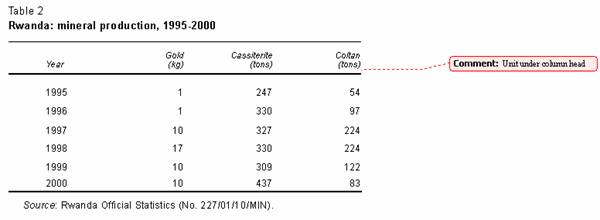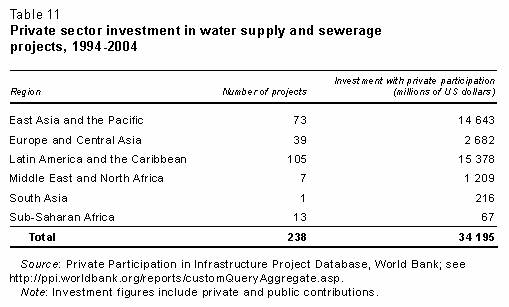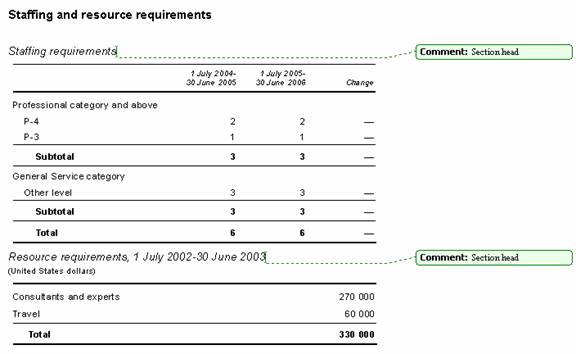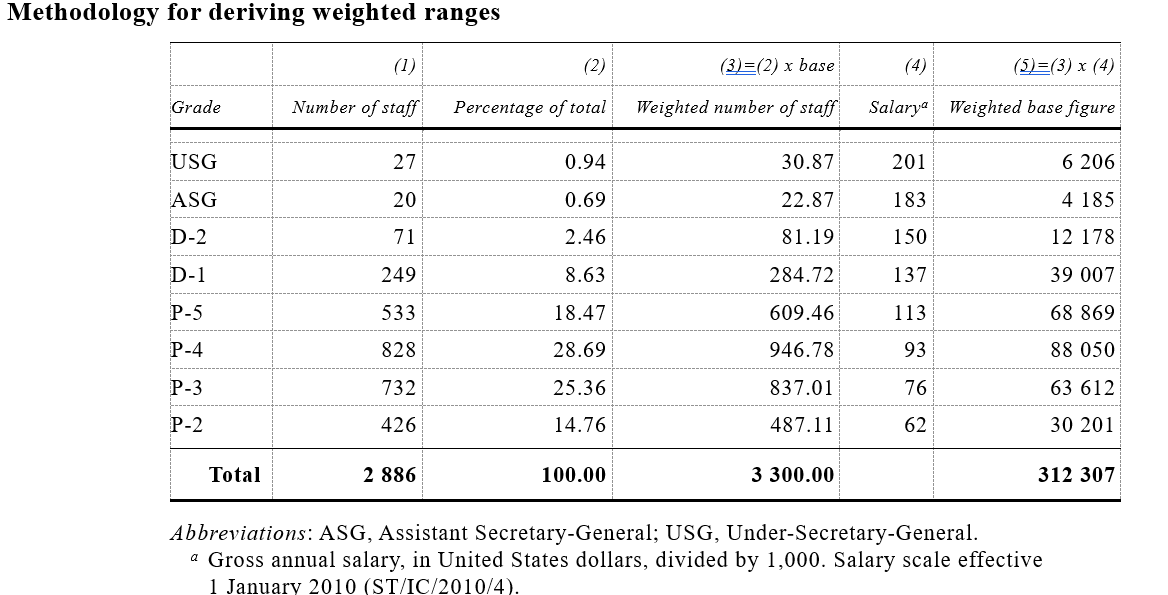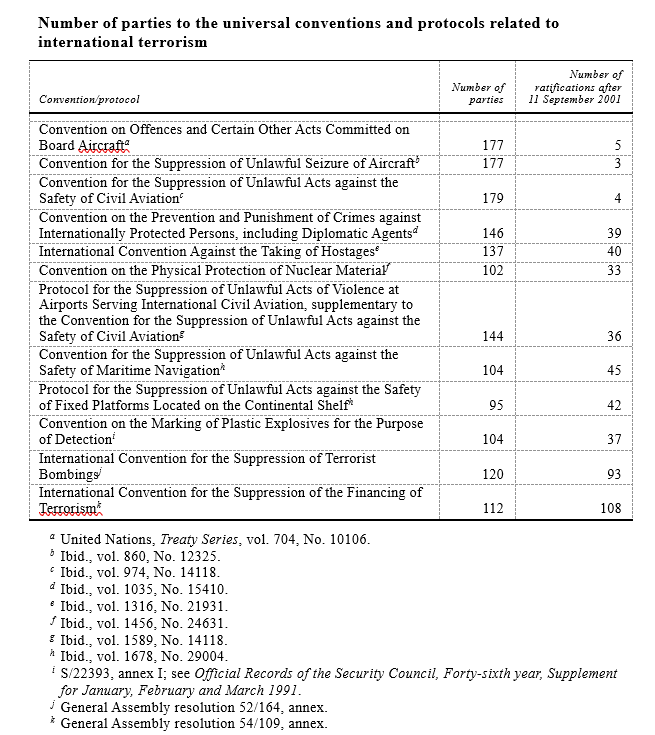- عربي
- 中文
- English
- Français
- Русский
- Español
Editorial Manual
Tables
Contents
| Introduction | |
| Parts of a table Table number Table title |
Abbreviations Notes to tables Symbols Key to tables |
| Headings Headnote Section heads Column heads Spanner heads Cut-in heads |
Text tables and other unnumbered, untitled tables Text tables Other unnumbered, untitled tables |
| Table body Stub Cells Totals and subtotals Alignment |
Introduction
This section provides information on how to organize tabular material for publication in United Nations documents.
The author of a text is responsible for the construction of tables and for their accuracy. Authors should organize tables in accordance with the guidelines set out below and follow established formats to the extent possible. The editors are available for consultation on how best to display tabular material. Authors should, however, consider the best way to present data. It is neither necessary nor desirable to include numerous tables in a document; data may be better stated in the text.
Editors will read the tables with an eye to correcting stylistic errors, checking facts and ensuring consistency among tables in a given document. Editors are not responsible for checking calculations. Tables should be as simple as the data allow and should be able to stand on their own, without further explanation.
All United Nations documents, tables included, are to be submitted in Microsoft Word or Excel only (see editorial directive ST/CS/SER.A/44/Rev.1 and the DGACM guide to document submission in Editorial guidelines/Instructions for the preparation of documents). It should be noted that tables submitted in Excel will not be included in the PDF version of the document on ODS.
A table generally consists of at least two vertical columns and two horizontal rows. Horizontal rules (lines) mark the top and bottom of the table and separate the column heads from the table body. Rules are not used to separate lines of data.
Vertical rules are not used in United Nations documents, either to separate columns or to box the sides of the table. Shading should never be used.
Tables may be in portrait (vertical) or landscape (horizontal; also called “broadside”) orientation.
Parts of a table
Table number
Tables are normally numbered consecutively throughout the main part of a document with arabic numerals, beginning with “Table 1”. In most cases the table number is stacked flush left above the table title (see example 1).
Example 1:

In the fascicles of the proposed programme budget, however, the table number hangs in the margin to the left of the title (see example 2). The same style (i.e. the table number on the same line as the table title) may also be used in publications.
Example 2:

If there is only one table in a document, it is not numbered and the word “Table” is omitted from the heading.
A double enumeration system (Table I.1, Table I.2, Table II.1 and so on; see example 12) may be preferable when the table numbers must be linked specifically to numbered chapters or other major divisions of the text.
In documents containing annexes, number the tables separately for each annex, beginning with “Table 1” each time. If there are tables in both the main part of a document and its annexes, double enumeration may be used for annex tables (Table A.1 etc.) to avoid confusion.
Every table that is included in a document should be mentioned in the text. The word “table” is lower case in text references (e.g. “see table 1”).
Tables are cited by number (unless there is only one) rather than by a phrase such as “the table below”. This system allows some flexibility in the placement of tables so as to avoid awkward page breaks. The rule does not apply, however, to web pages or electronic publications, since the problem of page breaks does not arise.
Figures (charts, graphs and photographs) form their own series and are numbered separately from tables, with roman numerals. Maps are numbered with arabic numerals, also in a separate series (see also Maps and figures).
Table title
Each table should have a concise, descriptive title stating the main subject of the table.
The title is set in bold type, flush left and stacked below the table number. Only the first word and any proper nouns or adjectives are capitalized.
It is not necessary to repeat information given in the column headings. For instance, in example 3 the title originally read:
Number and percentage of female staff, by grade, in posts subject to geographical distribution and posts with special language requirements (1993 and 2003)
It was simplified to read:
Example 3:

Headings
Headnote
A short explanatory note that applies to all values in the table, such as the unit of measure, is enclosed in parentheses flush left below the table title, just above the top rule (see examples 4 and 14).
Only the first word and proper nouns and adjectives are capitalized. The headnote is in roman type (not italics or bold). Abbreviations are not used, as space is not a consideration. For example:
(Thousands of United States dollars) not (000 US$)
(Percentage) not (Per cent) or (%)
(Volume in thousands of tons; value in billions of Icelandic kronur)
(Cultivation in hectares)
Example 4:
If the units of measure differ from column to column, however, each unit should be specified in the respective column heading rather than in a headnote (see examples 5 and 6).
Example 5:
Example 6:
If a long explanation is required, it may be provided in a footnote rather than a headnote (see example 9, footnote a, and Notes to tables).
Section heads
Section heads are used when a table has two or more subdivisions that require different column heads. Section heads precede the column heads, are table width and are in italics (see example 7).
Example 7:
Column heads
Like table titles, column heads (also called “boxheads”) should be as concise as possible. They contain only information that applies to each element listed in the column.
A spanner head may be used to avoid repeating the same phrase in two or more columns (see Spanner heads).
Column heads are in italics, only the first word and proper nouns and adjectives being capitalized.
The left-hand column (the stub) does not always require a head, especially if the stub head merely repeats information given in the table title. For instance, in a table entitled “Countries receiving official development assistance”, the stub head “Country” would be redundant.
In certain cases the stub head is optional. For instance, in the first section of example 7, the word “Category” could be inserted as the stub head and be deleted from the table body, as shown in example 8.
Example 8:

If the stub column has a heading, it is usually singular (e.g. Member State; Category; Budget section).
A unit of currency should not be used as a column head; rather, the heading should describe the type of information included in that column (e.g. “Official development assistance”, “Exports” or “Amount”), with the currency specified either in a headnote (see second section of example 7 and example 14) or in parentheses under the column head (see example 6).
Column heads should be treated consistently throughout a work. They should never be entered vertically (i.e. perpendicular to the table), even to save space. To keep a column head from running to several lines and becoming difficult to read, it may be necessary to move some of the information to a footnote (see example 9).
If columns must be numbered, arabic numerals within parentheses are inserted above the column head (see example 9). Column numbers should be used only when necessary for text reference or to ensure a correct reading of the table.
Example 9:
Spanner heads
If a heading applies to more than one column, a spanner head (also called a "decked head") may be used to avoid repetition. A horizontal rule (“spanner rule”) below the head spans all columns to which the spanner head applies.
The column heads in example 10.A may be shortened by placing the words “Percentage of staff” in a spanner head (see example 10.B).
Example 10.A :

Example 10.B:

There may be more than one level of spanner head (see example 11).
Example 11:

Cut-in heads
Cut-in heads span all but the first (stub) column and function as subheadings within a table. They may be used when the column heads remain the same throughout the table (see example 12; see also Section heads).
Example 12:
Table body
Stub
The left-hand column of a table, or stub, normally contains a list of the categories or entities about which information is given in the other columns.
Items in the stub should be numbered only when referred to by number elsewhere in the text or to clarify multiple subdivisions within the stub. Leaders (series of dots) are not used to indicate the alignment of rows. Each item in the stub column should be typed continuously, without hard returns, so that it stays in the same cell (see Cells).
Stub items should be arranged in a logical sequence, which may be dictated by the purpose of the table or the nature of the data (e.g. to indicate a ranked order, hierarchy, chronological sequence or an order of magnitude).
If there is no other organizing principle, place the stub items in alphabetical order. In an alphabetical list of countries, follow the order specified in UNTERM. If the stub column includes both countries and areas that are not separate political entities, the heading must read “Country or area”.
Subheadings
The stub column may require subheadings. The subheading may be in regular type (not bold or italic), in which case the entries under it are indented (see example 12), or it may be in bold type, in which case the entries are not indented (see example 13).
Example 13:

Cells
The cells of a table are the spaces created by the intersection of columns and rows, which are used to display the data. Do not leave any cells blank. If no information is available, supply an appropriate symbol to explain the absence of data (see Symbols).
In figures exceeding 1,000, a space is used in place of a comma (see “Punctuation of figures” in Editorial guidelines/Style/Numbers, dates and time).
Ditto marks are not used to indicate the repetition of items; instead, the information is repeated. In cases where lengthy text is repeated in the next row, “idem” may be used.
Totals and subtotals
Totals and subtotals set out horizontally are indented and in boldface type. They are separated by horizontal rules from the rows immediately above and below. Totals and subtotals in columns, however, are in roman type, not bold.
It is not necessary to total a single line of data. The sums of subcategories are expressed as subtotals rather than as several separate totals. The term “grand total” is used only if a third category is needed (see example 14).
Example 14:
Alignment
In columns of numbers, if all the figures are expressed in the same unit of measurement the numbers are aligned on the decimal point, or on the right in the case of whole numbers (see example 12). All decimal numbers should be carried to the same number of places. For amounts less than 1.0, a zero normally precedes the decimal point.
In columns including numerical data expressed in various units, the figures may be centred. Columns consisting only of text are normally aligned on the left (see example 15).
Example 15:

Abbreviations
Abbreviations should not be used in table titles or headnotes, where space is not a consideration. They should be avoided where possible in column heads and the table body, with the following exceptions:
- “United States dollars” may be abbreviated as “US dollars” to save space.
- Months of the year may, when necessary, be abbreviated as follows: Jan., Feb., Mar., Apr., May, June, July, Aug., Sept., Oct., Nov., Dec.
- Dates should be written out in full: 1 January 2021. If there is not enough space, the month may be abbreviated: 1 Jan. 2021. In order to avoid confusion, dates should not be abbreviated in a numbers-only format, e.g. 1/1/2021.
Other abbreviations may be used on an ad hoc basis when necessary to save space, provided that they are explained in a footnote to the table (see Notes to tables) or previously in the text. In publications, abbreviations listed in the explanatory notes included in the front matter may be used in tables.
Always spell out the word “Number” in table titles and column headings (see examples 6 and 16).
Example 16:
The general guidelines on abbreviations and acronyms (see Editorial guidelines/Style/Abbreviations and acronyms) also apply whenever possible in tables. Country names are not normally abbreviated; however, if space is extremely tight, abbreviations such as “Rep.”, for “Republic” may be used. The shortened forms “United Kingdom” and “United States” are acceptable in tables.
Notes to tables
Items appearing below the table may include the following:
- Source notes (see examples 4 and 5)
- Explanatory notes (see example 6), including abbreviations or symbols used in the table (see example 9)
- Footnotes (see examples 9 and 16) .
Items are displayed in that order and are grouped at the end of the table.
The words “Source(s)”, “Note(s)” and “Abbreviation(s)” are indented, printed in italics and followed by a colon.
Information additional to that given in the title or that is applicable to the table as a whole may be provided in a note to the table (see example 6) or a footnote to the title.
Use lower-case letters in italics as indicators for footnotes to most tables. The letters are read across, rather than down, the columns. For a series of footnotes that would extend beyond the letter z, use arabic numerals instead of letters.
A footnote indicator attached to a column head or a stub entry refers to the entire column or row and therefore is not repeated within that column or row.
If an item requires more than one footnote, the indicators are separated by a comma. If two or more notes apply to only one item, however, they should be combined in one note (see, for example, footnote a in example 9).
Wherever possible, use phrases, rather than complete sentences, in footnotes. The present participle of a verb, rather than the present or past tense, should be used (e.g. “Excluding livestock” rather than “Excludes livestock”).
For abbreviation notes, either of the following forms may be used:
FAO, Food and Agriculture Organization of the United Nations; GDP, gross domestic product; NGO, non-governmental organization.
or
FAO Food and Agriculture Organization of the United Nations
GDP gross domestic product
NGO non-governmental organization
Symbols
The following symbols may be used in tables:
An en dash (–) indicates that the amount is nil or negligible
Two dots (..) indicate that data are not available or are not reported separately
(n/a indicates that the item is not applicable)
Negative amounts are normally placed in parentheses ( ) in financial tables. Alternatively, a minus sign (-) may be used.
In reports, symbols may be explained in a footnote to the table (see Notes to tables). In publications, they are normally identified in the explanatory notes included in the front matter.
Key to tables
A key to a table may appear as a centred headnote above the table or as an explanatory note below the table. It may be given in one of the following forms:
A: estimates
B: appropriations
C: allocations
or
A, estimates; B, appropriations; C, allocations.
Text tables and other unnumbered, untitled tables
A succession of figures that would occupy only a single row of a table need not be set in a tabular format. Instead, the data should be incorporated directly in the text (see example 17), or set out in a text table.
Example 17:
Prices increased by 2.5 per cent in 2001, 2.3 per cent in 2002 and 2.0 per cent in 2003.
Text tables
Text tables may be used, in isolated instances, to set off from the rest of the text a limited amount of data.
A text table is introduced by the preceding text, normally by a colon.
A text table normally has no horizontal rules or column heads, but it may include one or more footnotes (see example 18) or section heads (see example 19).
Example 18:
| The total estimate for other staff costs is $159.6 million at 2004–2005 rates, comprising (in thousands of United States dollars): | |
| Temporary assistance for meetings | 37 102.0 |
| General temporary assistance | 24 834.4 |
| Overtime and night differentiala | 17 640.8 |
| Personal service contracts | 1 149.9 |
| Other personnel-related costs | 13 599.8 |
| After-service medical coverage | 65 317.9 |
| Total | 159 644.8 |
|
a Estimate based on expenditure in 2002–2003. |
Example 19:
| The budget performance of the Department of Peacekeeping Operations for the period 2004/05 is as follows: | |
| Resources (millions of United States dollars): | |
| Approved | 72.9 |
| Expended | 70.4 |
| Posts: | 1 149.9 |
| Approved | 537 |
| Encumbered | 594 |
Other unnumbered, untitled tables
In financial documents, and occasionally in other documents, a table may open a section of a document. In such cases the title or subtitle of the section is also the title of the table (see examples 20 and 21).
Example 20:

Example 21:




